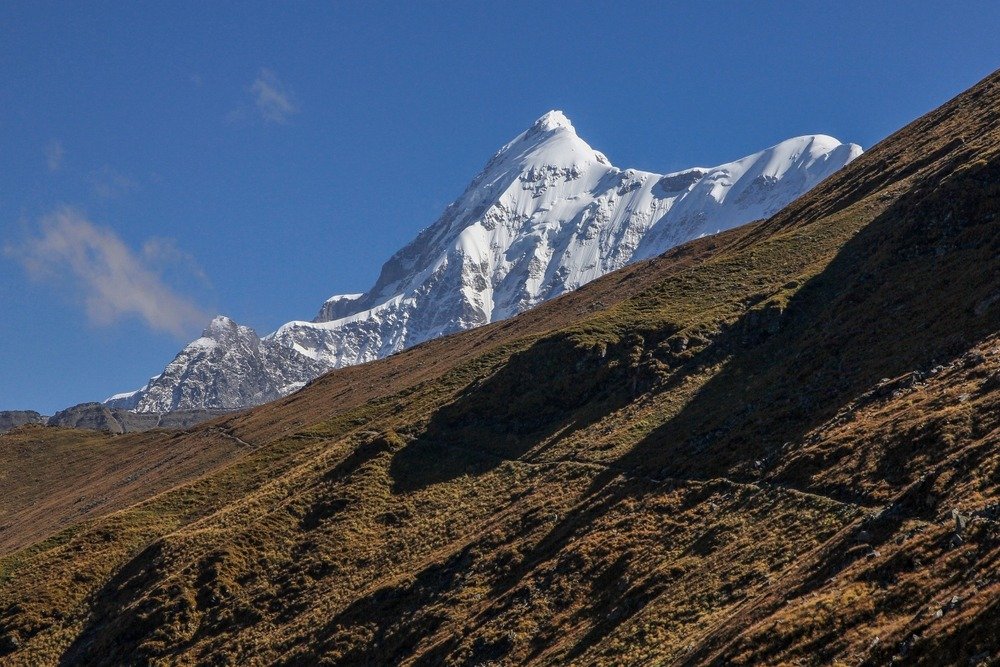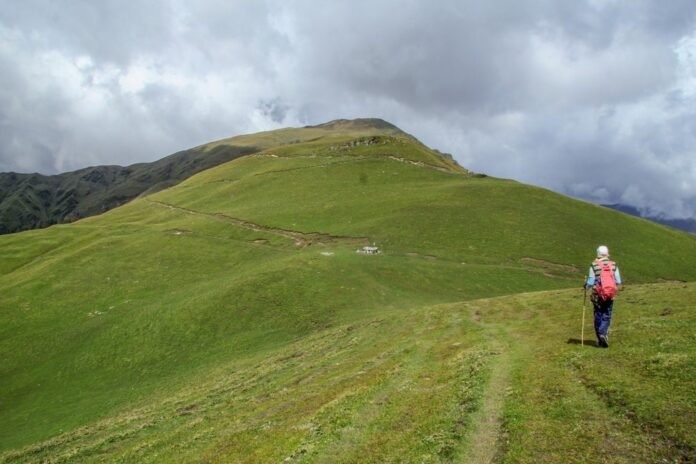Introduction to the Ali Bedni Bugyal Trek
If you’re like me, you’ve probably dreamt of escaping to the quiet, lush meadows of the Himalayas, surrounded by breathtaking views of snow-capped peaks. For me, the Ali Bedni Bugyal Trek was one of those treks I’d been waiting to cross off my list. Located in Uttarakhand, India, it’s a mesmerizing journey through alpine meadows (locally known as bugyals), dotted with vibrant wildflowers and offering panoramic views of Mount Trishul and Nanda Ghunti. However, like many treks that offer such beauty, it has become popular among adventurers, which means crowds. For someone who prefers solitude and the serene experience that trekking brings, I had to plan carefully to avoid the masses.
Why Avoiding Crowds Enhances Your Trekking Experience
Let’s be honest—when we go trekking, we’re not just looking for a workout. We’re looking to escape from the noise of daily life and reconnect with nature. For me, the charm of trekking lies in hearing the crunch of the trail underfoot, the rustle of the wind through trees, and the stillness of a remote campsite. But large crowds can take away from that magical experience. With too many people around, the peacefulness diminishes, and suddenly, the trek feels like a bustling tourist spot instead of the serene wilderness I crave.
When I trekked Ali Bedni Bugyal, I noticed that avoiding the crowds made a huge difference. It allowed me to:
- Savor the scenery: With fewer people, there were no distractions, and I could appreciate the beauty of the meadows without interruption.
- Move at my own pace: I wasn’t constantly overtaking or being overtaken by groups.
- Find peace at the campsites: Fewer people meant quieter nights under the stars.
The Ideal Time to Visit Ali Bedni Bugyal Trek with Fewer Crowds

After doing some research and speaking with locals, I learned that the key to enjoying the Ali Bedni Bugyal Trek with fewer crowds is all about timing. The busiest trekking months are May to early June and September to October when the weather is perfect. These are the months when the trails are bustling with trekkers, which I wanted to avoid. I concentrated on the shoulder seasons—those that come right before or right after the peak season.
Ali Bedni Bugyal Trek During Pre-Monsoon Season (April to June)
When I first thought about trekking in April, I wasn’t sure if the weather would be ideal, but I was pleasantly surprised. It turned out that the best month to avoid the throng was April. The trek was peaceful, the trails were not packed, and the temperature was just right—cool but not freezing. Plus, the meadows were just starting to bloom with fresh grass, and the snow from winter was still visible on the higher peaks, creating a gorgeous contrast.
The route can get very congested in late May or early June due to Indian school holidays and summer vacation. If you’re planning to go during this period, I would recommend trying to head out in early May before the holiday rush or even sticking to April to fully enjoy the tranquility.
Ali Bedni Bugyal Trek During Post-Monsoon Season (September to November)
The post-monsoon season, especially in late September or early November, is another great time to beat the crowds. This is the time when the weather clears up after the monsoon rains, leaving behind fresh, vibrant landscapes. The air feels crisp, and the skies are clear, offering magnificent views of the surrounding mountains.
I trekked in early November, and while it was colder, the trails were practically empty. I had the impression that the place was all mine. The cold was manageable with the right gear, and the snowcapped peaks were absolutely stunning. For those looking for solitude and beautiful vistas, I can’t recommend November enough. It’s colder, yes, but the peace and quiet more than make up for it.
Winter Hiking: A Calm Retreat (December to February)
Now, if you’re someone who doesn’t mind the cold (or actually enjoys it), winter trekking can be an entirely different adventure. From December to February, the Ali Bedni Bugyal Trek transforms into a snowy wonderland. When I first heard about trekking in winter, I was skeptical—it sounded tough. And to be fair, it is! But for someone craving complete solitude, there’s no better time to go.
The trails are covered in snow, and the entire landscape changes. You won’t find any large groups, and the campsites are peaceful, albeit a bit chilly. Of course, winter trekking requires proper preparation: layered clothing, winter gear, and sometimes even hiring a guide since parts of the trail can become more challenging to navigate. But if you can brave the cold, it’s a magical experience that very few people get to enjoy.
How to Choose the Right Days in Peak Season
Sometimes, avoiding peak season altogether may not be an option, and that’s okay. Even during peak times, there are strategies to minimize crowds. Based on personal experience, I have discovered:
- Weekdays are better than weekends: Most people prefer trekking on weekends, so if you can take time off during the week, you’ll definitely encounter fewer crowds.
- Avoid trekking during Indian public holidays: Holidays like Independence Day (August 15), Dussehra, and Diwali are times when many people head to the mountains, so plan your trek around these dates if possible.
- Start early: I’ve found that starting your trek early in the morning gives you a few precious hours of solitude. Most trekkers prefer to start later in the day, so you’ll get the trail almost to yourself if you set out at dawn.
The Impact of Holidays and Festivals on Trekking Crowds
It’s essential to be aware of Indian public holidays and festivals when planning your trek. Trust me—nothing takes you by surprise like arriving at a trail, expecting peace, and finding it packed with families enjoying a holiday getaway. Trekking during festivals like Holi or Diwali can be quite crowded, as many locals and tourists use these breaks to escape into nature. Avoiding these times is key to a quieter experience.
Exploring Lesser-Known Trekking Routes Around Ali Bedni Bugyal
One of the ways I avoided the crowd was by researching lesser-known trails that connect with the Ali Bedni Bugyal route. For example, combining this trek with routes like Roopkund or Kuari Pass can help you stay off the main path where most trekkers go. These alternate routes are equally beautiful and offer the same Himalayan charm without the mass influx of people.
Advantages of Solo Trekking vs. Group Trekking
I usually prefer solo trekking or traveling with a small group of friends. Solo trekking offers unmatched freedom—you move at your own pace, stop whenever you want, and really soak in the environment. However, if you’re trekking in an unfamiliar region, having a local guide or joining a small group can be helpful, especially if you’re going during the off-season when the trails are less traveled.
Importance of Early Morning Starts for a Solitary Experience
There’s something incredibly peaceful about being the first person on the trail. Starting early has always been my secret to avoiding crowds. On the Ali Bedni Bugyal Trek, setting out at dawn gave me a few golden hours of complete solitude, and I could enjoy the stunning sunrise over the meadows and mountains without any interruptions.
Booking in Advance for Exclusive Trekking Experiences
Booking your campsites or hiring a trekking guide in advance, especially during busier months, can be a lifesaver. Not only do you avoid the rush, but you also ensure that you have a spot reserved at less crowded campsites. Some trekking companies offer smaller, more exclusive group experiences, which can make a world of difference if you’re looking for a quieter trek.
How Guided Treks Can Help with Crowd Control
I’ve always found that going with a local guide during off-peak times adds immense value to the experience. Guides often know the quieter spots, alternate paths, and hidden gems that are less frequented by the average trekker. Plus, they share interesting facts about the local culture, flora, and fauna that you might miss otherwise.
If you’re planning to explore the beauty of the Ali Bedni Bugyal Trek and want a hassle-free, well-organized experience, I highly recommend The Searching Souls. They offer excellent guided treks, ensuring you get the most out of your journey with the perfect balance of adventure and comfort.
Eco-Friendly Trekking to Preserve the Beauty of Ali Bedni Bugyal
It’s easy to forget, but with growing crowds comes an increased impact on the environment. Overcrowding can harm the delicate ecosystem of the meadows, so it’s important to trek responsibly. I always make sure to carry my trash out with me, avoid using single-use plastics, and stick to designated trails to minimize my environmental footprint. We all play a role in preserving the beauty of places like Ali Bedni Bugyal for future generations to enjoy.
Conclusion: Finding the Perfect Time for Your Trek
To sum it up, the best time to enjoy the Ali Bedni Bugyal Trek with fewer crowds is during the shoulder seasons—either early April or late September to early November. Winter is another quiet, if challenging, option for those who are well-prepared. By planning carefully and using these tips, you can experience the serenity and beauty of the Ali Bedni Bugyal without the distraction of large crowds.
